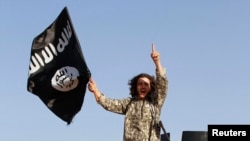The black flag of the Islamic State (IS) militant group has reportedly been raised in areas of northern Afghanistan, just south of the border with Central Asia. These reports have been noticed in those neighboring countries, adding to the concerns officials in Ashgabat, Tashkent, and Dushanbe already had.
RFE/RL's Turkmen Service, known locally as Azatlyk, has been reporting about the black flag being seen in northwestern provinces of Afghanistan and RFE/RL's Gandhara website has been reporting about that flag being seen in northeastern Afghanistan.
The UN's top envoy to Afghanistan, Nicholas Haysom, told the UN Security Council on March 16 that the IS is present in Afghanistan but has not yet planted "firm roots."
There seems to be ample evidence the black flags are appearing not far south of Central Asia's border but it remains unknown how many people there are rallying around the IS banner and what is attracting them.
Azatlyk organized a roundtable on IS presence in northern Afghanistan and looked at the possibilities that flag could one day be seen on the northern side of the "Oxus."
Participating in the panel discussion were Afghan members of parliament Nahit Fareed and Shukriya Barakzai, and Thomas Ruttig, co-founder and co-director of the Afghanistan Analysts Network, to get their views on the IS presence in Afghanistan.
Qishloq Ovozi has reported earlier on Commander Bobi in the northwestern Faryab Province, who claims there are IS militants near his district and in neighboring Jowzjan Province, along the border with Turkmenistan. RFE/RL's Gandhara website has quoted Konduz Governor Mohammad Omar Safi saying IS militants are in his northeastern province, along the border with Tajikistan and not far from the border with Uzbekistan.
Turkmenistan has been fortifying its border with Afghanistan for several months. Tajikistan has been doing so for many years, but this month also conducted an exercise along the Afghan border that included some 50,000 people -- soldiers, reservists, local police, and medical and transportation workers, whose services could be needed if hostilities break out.
Ruttig said there was reason for concern but he was not sure the main threat is the IS. "We have looked at the different places and we actually have only found in three [places] and in of all of those they were local groups who had either been Taliban before or Hezb-e Islami," Ruttig said. As for reports that cite high figures of hundreds or even 1,000 IS militants, Ruttig advised removing "one zero" from the end of those numbers.
Fareed also agreed there was a militant problem in northern Afghanistan but said some of those now claiming to be IS are only interested in using the brand name. "There are groups that have never been taken seriously. They swear their allegiance to [IS] that's because they want to draw attention," she said.
Barakzai noted that "right now for those [IS] militants it is a good opportunity, because the government of Afghanistan starts a new chapter of the peace process within Afghanistan" and "some part of the Taliban will not accept this kind of peace process."
UN envoy Haysom said approximately the same in his address to the Security Council, noting the IS potential "to offer an alternative flag pole to which otherwise isolated insurgent splinter groups can rally."
It would be difficult to say if that's much comfort to Central Asia. Hundreds of people from Central Asia have gone to Syria to join IS and several thousand have gone to Afghanistan and Pakistan, most to join the Islamic Movement of Uzbekistan (IMU) or one of its affiliates or offshoots.
But the Pakistani military's offensive in North Waziristan has driven out many of these Central Asians and sent them into northern Afghanistan. They are still nominally part of the IMU but forced from their havens in Pakistan they could be easy targets for IS recruitment in Afghanistan.
Fareed said it would be in keeping with IS efforts to spread their movement. "They want to have some kind of network between Central Asia and South Asia, I mean in Uzbekistan and Tajikistan, in Pakistan, and Afghanistan is a good route. It's dangerous," she said.
Fareed also said the Afghan government had been and continued to work with its Central Asian neighbors "to counter such kind of activities, not only [IS], any activity that can be a threat against the governments of these countries."
The panelists spoke much more about who might be IS militants in Afghanistan and who is likely not, about their numbers, and their prospects in gaining a foothold in Afghanistan.
The quality of the audio at times leave much to be desired, connections to Afghanistan can still be complicated and frustrating. But the information to be gleaned from the discussion is valuable and hopefully will make up for some background noise and break-ups in some sentences.
Listen to the full audio recording here:
-- Bruce Pannier







